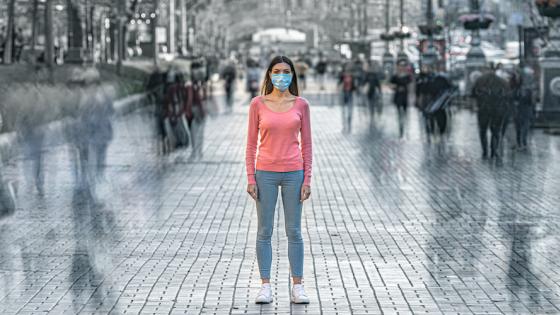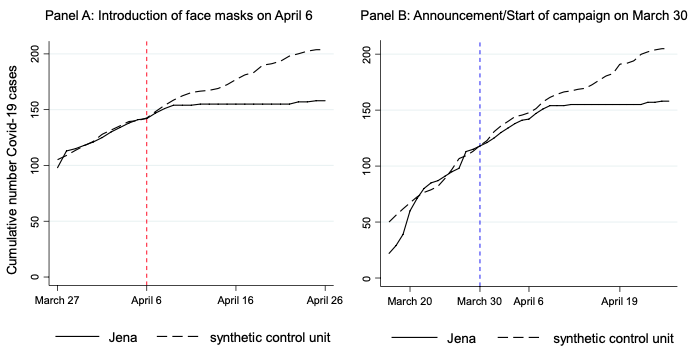On a global scale, the extent of COVID-related lockdowns is massive, and their socio-economic impact is expected to be far-reaching (Barba Navaretti et al. 2020, McKibbin and Fernando 2020). When it comes to the estimated effects of containment measures, timing seems to matter (Deb et al. 2020).
In Germany, significant actions to reduce the spread of the virus have been taken from mid-March onwards (Hartl et al. 2020). However, the obligation to wear face masks in public has been the subject of controversy and was introduced only relatively late throughout Germany (around 27 April 2020).
At present, virologists are collecting more and more clinical evidence that face masks catch infectious particles produced from speaking, coughing, or sneezing, which may reduce the risk of infecting another person (Prather et al. 2020). Proper wearing of a face mask could thus help to reduce the spread of COVID-19 and protect risk groups from infections in a cheap and simple way.
Finding out whether face masks indeed reduce the spread of COVID-19 is thus important. Against the available evidence from clinical studies or previous pandemics, we ask: Can we identify a significant effect of face masks on the spread of COVID-19 by looking at the development of registered COVID-19 cases? Yes, we can. We zoom in on the case of Jena, a town of 110,000 inhabitants in the federal state of Thuringia, Germany.
Jena presents a unique case in Germany (see also Mitze et al. 2020), as the obligation to wear face masks in public transport, shops, and workplaces was introduced much earlier there (on 6 April) than in all other regions in Germany (around 27 April). The introduction of obligatory face masks was accompanied by a public campaign “Jena zeigt Maske” (“Jena shows mask”), which started one week earlier to make the local population aware of this novel measure.
We can observe differences in the timing of introducing face masks across German regions due to the institutional setup of the German federal system: according to the German Infection Protection Act, federal states are in charge of formulating and prescribing public health measures to fight the spread of infections. Local municipalities and health authorities then decide on the implementation of specific measures, e.g. the timing of their introduction. And Jena was the first to act.
If we look at the number of COVID-19 cases in Jena, masks seem to have a positive effect. The number of registered new infections fell to almost zero in the days after masks were introduced. But was this really due to the introduction of masks and a publicly visible campaign? Unfortunately, there is no second Jena in Germany, which would allow us to measure the spread of COVID-19 if face masks had not been introduced under otherwise identical conditions.
Our solution is to apply the synthetic control method (Abadie and Gardeazabal 2003, Abadie et al. 2010, Abadie 2020) to construct a counterfactual that closely follows the COVID-19 trend in Jena before masks were introduced. The idea is to construct a weighted average of similar regions in Germany (with no mask obligations) at the time when mask-wearing became compulsory in Jena.
Regions and their respective sample weights are chosen based on the cumulative number and changes in newly registered COVID-19 cases before 6 April, together with structural regional characteristics such as regional population density, average age of the population, proportion of senior citizens, and average number of doctors and pharmacies per inhabitants. In the baseline, both West and East German cities such as Rostock, Darmstadt, and Trier constitute this synthetic Jena (see Mitze et al. 2020 for the full list).
We then use this counterfactual to estimate the hypothetical change in cases in Jena after 6 April. This tells us approximately what would have happened if no masks had been introduced in the city.
Table 1 shows a significant difference in the number of cases in Jena and the comparison group without masks after 6 April. Twenty days after the introduction of mandatory masks in Jena, the cumulative number of COVID-19 cases increased from ‘only’ 142 to 158. In the synthetic Jena, the number rose from 143 to 205. This corresponds to a reduction in the number of cases by around 23%.
Table 1 Estimated effects of face masks on COVID-19 cases
Notes: The sample of all municipal districts in Germany covers 401 regions; the subsample of cities covers 105 larger cities (kreisfreie Städte). For details, see Mitze et al. (2020).
We find that the difference is most striking for the over-60 age group. For this group, the increase in cumulative cases in Jena decreased by more than 50% compared to its synthetic control group (see Mitze et al. 2020 for details).
Panel A in Figure 1 shows that the effect gradually appears over time. However, its gradual emergence after about 3-4 days is too fast from an epidemiological point of view. With COVID-19’S average incubation period of approximately 5 days and a potential reporting delay of 2 or 3 days for laboratory results (Donsimoni et al. 2020), effects on reported new cases should only be seen after 7 or 8 days. An announcement effect may have played a role in Jena.
In panel B, we therefore start our analysis on 30 March, the day the mask campaign was announced. In this case, we observe a widening gap between Jena and the comparison group after about 10 days. Taken together, this effect appears to be plausible and is found to be robust when confronted with different sensitivity tests (see Mitze et al. 2020 for details).
Figure 1 Treatment effects of face masks in Jena over time
Still, can we draw conclusions for other regions or even other countries from a single case when we cannot completely rule out that Jena is special because of unobserved factors? We therefore go beyond a single case study and examine all those regions that had introduced masks before or by 22 April. Besides Jena, these include regions that required masks before the state-wide requirement was introduced (Nordhausen in Thuringia, Rottweil in Baden-Württemberg, the Main-Kinzig district in Hesse, and Wolfsburg in Lower Saxony), as well as all regions in Saxony and Saxony-Anhalt. We compare these regions with the majority of German regions that only introduced masks on 27 April or later. The main advantage is that we can calculate an average effect over different regions, although this comes at the expense of differences in the timing of introduction, which are smaller.
We find smaller effects than in the Jena case study (Table 1). However, the average reduction in case numbers compared to their synthetic counterparts remains significant and sizable. Depending on the chosen sample, 10 days after the introduction of masks, the decrease in the cumulative cases is between 2.3 and 4.2%. Generally, the effect is larger for the subsample of larger cities (kreisfreie Städte).
Based on our findings, we calculate a rule-of-thumb measure for the relative decrease in the daily growth rate of COVID-19 cases of about 40% (Table 1). Consider a region in which the number of COVID-19 cases increased by 10% from one day to another. This increase would have been only 6% if there had been an obligation to wear face masks. With a 10% daily increase in COVID-19, cases double within 7 days; in contrast, a 6% daily increase means cases double only within 12 days.
In summary, the introduction of mandatory face masks has slowed down the spread of COVID-19 in Germany. This result agrees with the findings of epidemiologists and virologists who explain that face coverings limit airflow when speaking, thereby reducing the transmission of infectious particles.
The observed effect in Jena is larger than the average effect for other regions with face-mask requirements. Two mechanisms may explain this difference: first, with Jena being a pioneer city in Germany when it comes to the introduction of face masks, the local population may have taken the crisis more seriously than in other regions, causing a sort of Hawthorne effect. In other words, the population may have taken the introduction of masks as a strong signal to follow contact restrictions closely. Another likely reason is that anticipation effects have increased over time in Germany: people in other regions may have chosen to wear masks even before wearing them became mandatory.
In sum, our results suggest that requiring masks is a cost-effective, less economically harmful, and democracy-compatible containment measure for COVID-19.
Authors’ note: We are grateful to Falk Laser and Philip Savage for very helpful suggestions and would like to thank Carolin Kleyer for excellent research assistance.
References
Abadie, A (2020), “Using synthetic controls: Feasibility, data requirements, and methodological aspects”, Journal of Economic Literature, forthcoming.
Abadie, A, A Diamond, and J Hainmueller (2010), “Synthetic control methods for comparative case studies: Estimating the effect of California’s tobacco control program”, Journal of the American Statistical Association 105(490): 493–505.
Abadie, A, and J Gardeazabal (2003), “The economic costs of conflict: A case study of the Basque country”, American Economic Review 93 (1): 113–32.
Barba Navaretti, G, G Calzolari, A Dossena, A Lanza and A Pozzolo (2020), “In and out of lockdowns: Identifying the centrality of economic activities”, VoxEU.org, 7 June.
Deb, P, D Furceri, J D Ostry, and N Tawk (2020), “The effect of containment measures on the COVID-19 pandemic”, VoxEU.org, 5 June.
Donsimoni, J R, R Glawion, B Plachter and K Wälde (2020), “Projecting the spread of COVID-19 for Germany”, German Economic Review 21(2): 181–216.
Hartl, T, K Wälde and E Weber (2020), “Measuring the impact of the German public shutdown on the spread of COVID-19”, VoxEU.org, 14 April.
McKibbin, W and R Fernando (2020), “The economic impact of COVID-19”, in R Baldwin and B Weder di Mauro (eds.), Economics in the Time of COVID-19, a VoxEU eBook, CEPR Press.
Mitze, T, R Kosfeld, J Rode and K Wälde (2020), “Face masks considerably reduce COVID-19 cases in Germany: A synthetic control method approach”, COVID Economics: Vetted and Real-Time Papers 27: 74–103.
Prather, K A, C C Wang, and R T Schooley (2020), “Reducing Transmission of SARS-CoV-2”, Science, 27 May.









